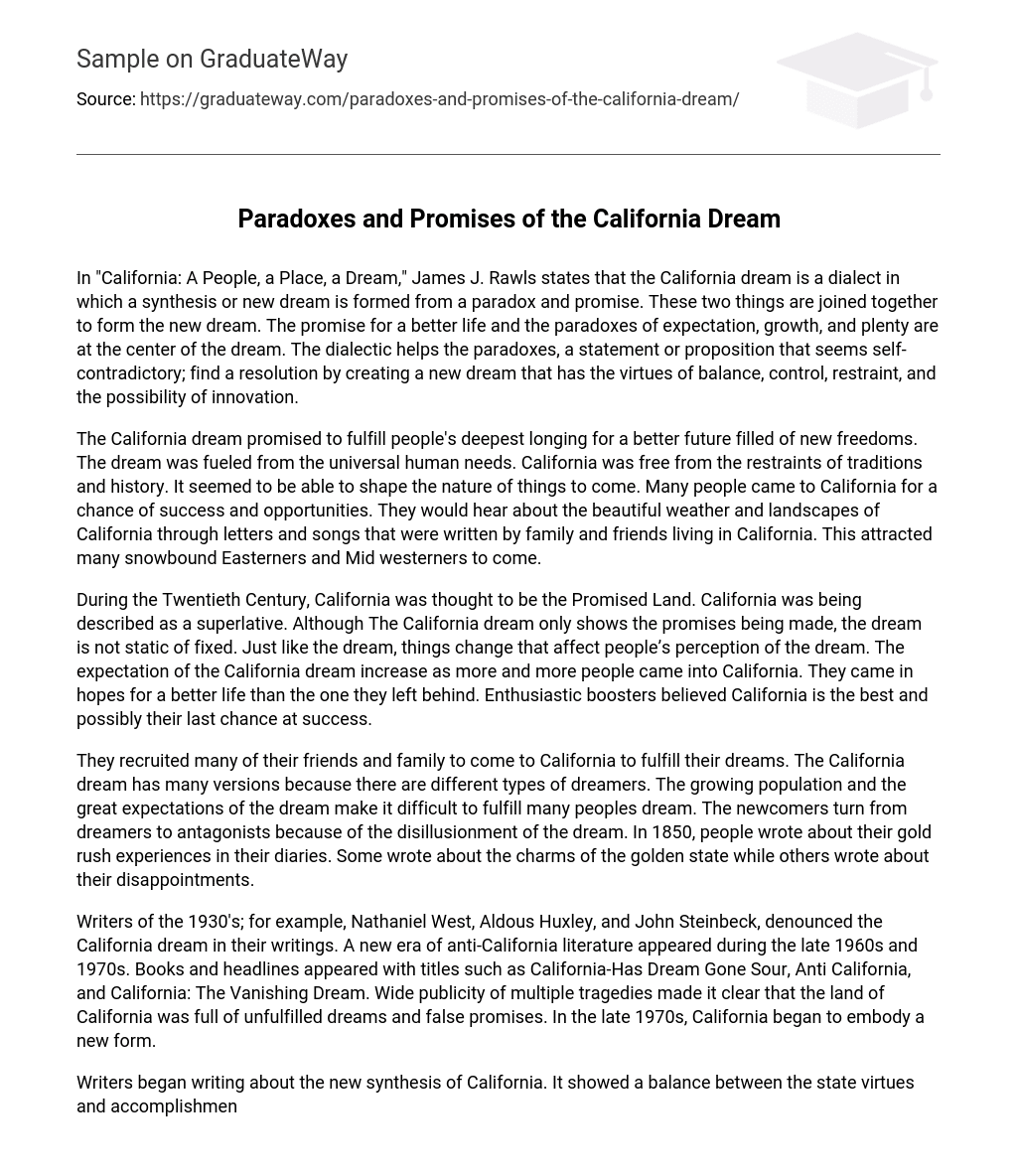In his book “California: A People, a Place, a Dream,” James J. Rawls argues that the California dream is a fusion of paradox and promise, resulting in a new dream. The promise of a better life and the paradoxical nature of expectations, growth, and abundance are integral to this dream. By employing dialectic, the conflicting elements find resolution, ultimately giving rise to a dream characterized by balance, control, restraint, and potential for innovation.
The California dream offered to satisfy individuals’ profound desires for a brighter future, rich in newfound freedoms. This dream originated from fundamental human needs and arose from California’s liberation from conventional customs and historical influences. The state appeared capable of shaping the course of the future. The allure of success and opportunities drew numerous individuals to California. Through letters and songs composed by relatives and friends residing in the state, people would learn about its stunning weather and landscapes. This enticed many individuals from snowy Eastern and Midwestern regions to relocate.
California was considered the Promised Land during the Twentieth Century, being described as a superlative. However, the California dream is not stagnant or permanent. Similar to the dream itself, circumstances change and impact people’s perception of it. With an influx of people migrating to California in search of a better life, expectations for the California dream grew. Enthusiastic supporters believed that California was the ultimate opportunity for success, potentially being their final chance.
They convinced many acquaintances and relatives to relocate to California in order to follow their aspirations. The California dream can be understood differently, as it attracts various individuals in search of success. Nevertheless, the increasing population and lofty expectations linked to this dream pose challenges for many people aspiring to achieve their goals. Consequently, those who arrive as optimistic dreamers often find themselves becoming adversaries due to their disillusionment with the unattainability of their dreams. By 1850, people documented their encounters during the gold rush through diaries, wherein some praised the allure of the golden state while others detailed their letdowns.
During the 1930’s, writers like Nathaniel West, Aldous Huxley, and John Steinbeck criticized the California dream in their works. However, a new era of anti-California literature emerged in the late 1960s and 1970s with books and headlines such as California-Has Dream Gone Sour, Anti California, and California: The Vanishing Dream. These publications reflected an increasing awareness of unfulfilled dreams and broken promises in California. Multiple tragedies received widespread publicity, further emphasizing this issue. By the late 1970s, California had undergone a transformation.
Writers have started to explore California’s new synthesis, which reflects a harmonious blend of the state’s virtues, accomplishments, failures, and faults. California’s remarkable growth has long been seen as a positive aspect; however, realizing the promises of the California dream posed challenges. The state’s prosperity serves as a testament to its success, with population growth serving as a reassuring indication of the dream’s enduring strength. Following the discovery of gold in California, the arrival of miners seeking riches triggered a rapid increase in population.
By the height of the Gold Rush, the miners’ opportunity to acquire riches was lessening. As California became the most populous state in 1962, numerous inhabitants participated in a statewide observance of Population Day. Regrettably, population expansion has negative consequences. Dense cities and the creation of highways supplanted verdant fields and orchards. To manage and restrict this rapid growth, communities throughout the states enacted the Petaluma ordinance in 1973. Hence, a California that was once characterized by its astounding development is now recognized for its constrained growth.
The land plenty paradox revolves around the conflict between economic growth and safeguarding the environment, particularly in relation to money. The influx of people into California was primarily driven by the pursuit of wealth. The state’s riches were visible in places like Rodeo Drive in Beverly Hills, as well as the construction of new infrastructure. However, this economic development posed a threat to the environment. In 1969, an oil spill occurred on Santa Barbara’s beaches, followed by another spill in the San Francisco Bay two years later, which greatly angered Californians. The impacts of these spills intensified the environmental movement.
California has become the solar state of the union by creating a nonpolluting, renewable source of energy to protect the environment. It now houses 40 percent of the United States’ solar collector energy. In addition, PG&E built the world’s largest wind energy project in Solano County. These advancements were a result of the paradox of growth. Despite disillusionments and failures, the California dream continues to attract new generations from around the world.





